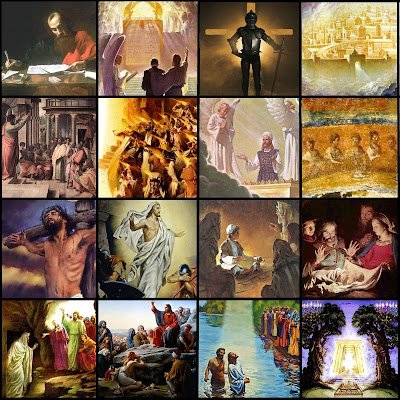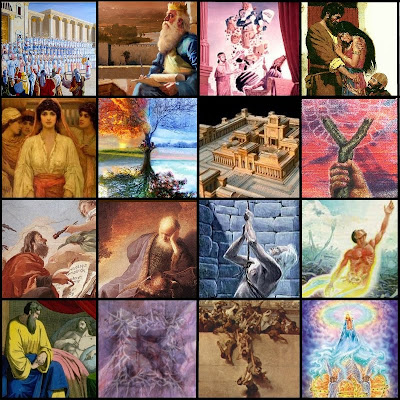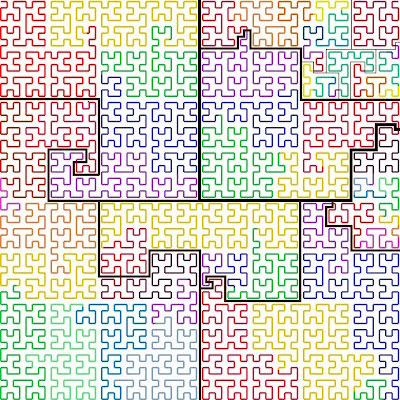Saturday, November 26, 2011
A grand idea
I believe there should be a device that looks something like a wall clock, but .for its face has an opening where a long roll of paper with the Bible printed on it is being constantly fed through. This would allow anyone in the room to let there eyes randomly fall on scripture at any time; people in the room could discuss interesting passages that went by as they noticed them. This device should be well designed like a nice clock so that people will be more drawn to it. It would be easy (trivial) to do this electronically as a screen saver, but what would be ideal is if it was actually a scroll printed in one column like one long page that somehow looped so that it would always be scrolling forward, my wife suggested a mobius loop which seems like a good idea but i still cant quite visualize how to roll up part of a loop to keep the object compact.
Saturday, September 3, 2011
Emphasizing what the Bible emphasizes
There is a lot of stress placed (rightly) on believing what the Bible teaches. But sometimes I get the feeling that after we have argued over the proper interpretation of one verse for hours and finally found out that it means what we thought it meant to start with, we sometimes are missing the forest for the leaf. The difficulty then is how to figure out how to properly emphasize different parts of the Bible:
perhaps the answer is to treat every word of the Bible with equal weight, and this seems at first like the best plan considering that it is all inspired of God. However it also seems ridiculous to say that 1 Chronicles 2:5 is of equal importance to John 3:16.
One strategy that I thought of would be to take an immense set of cross references and analize them the way Google analyzes hyper links to produce a "verse rank" (look up page rank if you don't know about this, it's pretty interesting) I would love to see this done, but don't know how to do it my self.
http://www.topverses.com/ uses popularity to determine its ranking of diferent Bible verses, there you can find all the verses of the Bible ranked by how often they are used, but this doesn't tell us which are the most important, merely which are believed to be most important.
So, what do you think? how do we determine what Bible passages are more or less important? or what am I missing in asking the question?
perhaps the answer is to treat every word of the Bible with equal weight, and this seems at first like the best plan considering that it is all inspired of God. However it also seems ridiculous to say that 1 Chronicles 2:5 is of equal importance to John 3:16.
One strategy that I thought of would be to take an immense set of cross references and analize them the way Google analyzes hyper links to produce a "verse rank" (look up page rank if you don't know about this, it's pretty interesting) I would love to see this done, but don't know how to do it my self.
http://www.topverses.com/ uses popularity to determine its ranking of diferent Bible verses, there you can find all the verses of the Bible ranked by how often they are used, but this doesn't tell us which are the most important, merely which are believed to be most important.
So, what do you think? how do we determine what Bible passages are more or less important? or what am I missing in asking the question?
Thursday, August 25, 2011
C.S.Lewis literary ancestry
In talking with one of my friends I came across the idea of a literary ancestry the idea that all writers were influenced by others and you could make a gigantic family tree of all of them. This project could very easily get out of hand if one attempted to show all the connections (surely in the hundreds for each author) but what if one merely chose the single biggest influence on each author. Now this is shakey ground because who that one influence is is quite debatable, but it is an interesting debate so let us charge forward with it. An easy starting place is C.S.Lewis who names his direct ancestor (his "master") as George MacDonald. MacDonald's work was a turning point in Lewis coming to Christ, Lewis used him as a character in The Great Divorce (as his Virgil, recalling Dante being guided by Virgil), and he made a collection of MacDonald's work. So then who was George Macdonald's bigest influence. The best I could come up with was a man named Novalis who wrote in very-dificult-to-translate German that George MacDonald translated. Now Novalis's childhood hero was Gottfried August Bürger who kept with him at all times Reliques of Ancient Poetry that a fellow named Bishop Percy compiled out of a manuscript of folk tales that he saved from being destroyed. That is my best stab at C.S.Lewis' main line of ancestry. Can you do better?
Friday, June 17, 2011
The Inhabited Web
I just installed The Inhabited Web on this blog, now whenever you are browsing here you can see small indicators along the side of the page that show the position of anyone else who is reading the blog. You can actually see other people who are on the same website with you.
Wednesday, April 20, 2011
Factor graph
Check this out. It's a pattern that I discovered about six years ago but this fellow has found out much more about it than I did. Here is another fellow who independently discovered the same pattern and whose picture of it I am using here. When I was first looking into it I could not find any references to it any where, considering that it is hard to Google something that you don't know the name of. I called it the factor graph, the first fellow I linked to called it the divisor plot, these are both perfectly logical names but Google is not smart enough to know that they are the same thing ^_^ .
Wednesday, April 6, 2011
The Lord's Prayer
This is a new project I am working on illuminating the Lord's Prayer with various scriptures that relate to each word, check it out here over at "Prezi". Prezi is a zooming presentation maker that allows me to actually place the other Bible texts inside the letters of the Lord's prayer. I feel that this project could be done better than I am doing it so if you want to try feel free to make a copy of it and improve it (right on the prezi sight). It is not currently finished (right now I have only finished "Our" "Father" and "Heaven") but you can check on my progress at that same link as I go, I will be posting updates and thoughts on the various passages and concepts as I go. It's interesting how a gimmick like this prezi tool makes this project so much more interesting to me than it would be other wise.
Labels:
Bible,
Commentary,
cross references,
Father,
Heaven,
Ilustrated,
Lord's Prayer,
Luke,
Mathew,
organization,
Our,
Our Father,
Presentation,
Prezi,
Themes
Monday, March 28, 2011
Bible outline tree
I'll be talking about a few ideas related to this coming up soon.
Labels:
Bible outline,
graph,
hierarchy,
nodes,
organization,
visualization
Monday, March 21, 2011
Hopefully this will one day be true...
in the decades after legalized abortion ended--as we began to come to terms with the holocaust we had been blind to for so long--the realization that a unique human life begins at the moment of conception began to seep into all parts of society. A number of memorials to the unborn began to crop up around the country. The main one, at the old headquarters of Planed Parenthood in Washington D.C., comments on the fact that about as many little ones were killed everyday as there were people who died in the 9/11 attacks. In a central area It displays 365 unique sculptures of little ones, each with a scalpel crossing their bodies, and next to one such sculpture another of the twin towers falling. In the area around this-reflecting these icons over a hundred times-there are mirrors, one for each of the years that abortion was legal and a few more to memorialize the little ones killed by illegal abortions. Looking in on this are statues of women in poses of mourning, symbolizing the mothers who lost children to abortion.
Labels:
Abortion,
after abortion,
future,
holocaust,
possible future,
pro-choice,
pro-life
Saturday, March 19, 2011
One sentance
This is a story I wrote in one continuous sentence; please tell me if the grammar is not correct in in some way. This is not a run on sentence because it only has one subject and one predicate. It might be called horrible style but I believe it to be correct grammar.
Away from the world that you and I know, far across the sea, on the island of orem, a small nation state tucked away in the place where the fold lines of a map that was torn out of the atlas long ago obscure the tiny squiggle that frames its coast, king Edward, who was known chiefly for his wicked conduct toward those still loyal, despite the persecutions they endured at his hand, to the king who he had unjustly taken the throne from, not in battle but by appeal to the least known and most foolishly penned, though nobly enough conceived, law in the great law book which, being filled with an hundred thousand controversies now with their organic furry having been extracted from them and replaced with cold and solid legalese, read like a fossilized history of those things great and small that had been important to various generations of oremeites and which was housed in the great library of orem, where it had often unseated and raised kings but never in so patently petty a way as it had unseated the former king and put Edward so precariously on the throne and for his use of that law book, twisted and turned, read and interpreted through those few pages that others would call obscure but he called central, reigned, awaiting with great fear, a fear born of the knowledge that he alone possessed that his interpretation of that one central law, of which the short man in the swirl-striped hat had taught him so long ago as he sat reading that strange book by the grandfather of the king, a book he had then thrown aside to march into the castle and demand of the king the throne by virtue of the fact that he was the person who, in all the kingdom, was least suited for it, was wrong and that any moment someone with a sharp eye (or reading glasses) could open the book to the one page which thankfully was still considered obscure and, bringing the true king from the cave by the sea, uncomfortably close to where the castle stood on orems southern coast, close enough that Edward would sometimes wonder if the seagulls that often stole his food were the same that the king had fed with crumbs from the rations of bread taken without ceremony to him each day, where he now lived in exile, could walk into the palace their footsteps echoing, like the footsteps he now heard, along the corridor of statues where Edward’s statute would never stand, and take one man away to shame and place one in the honor he deserved.
Labels:
fariy tale,
grammer,
king,
Laws,
one sentence,
Orem,
sentence,
story
Monday, March 14, 2011
Explanation of the Colors in the Map.
A number of people who saw the Bible map have asked what the colors mean and what they have to do with the contents of each book. The first principle i followed in choosing the colors was to make each of the seven sections distinct by going through the rainbow once each section. This led to using the same set of colors for each section that had the same number of books which was good because it pointed out some of the correspondences between the different sections that have the same number of books. (the last three OT History Books are post exile as are the last three minor prophets for example) To make the set of twelve colors I subdivided the set of five colors which worked especially well for the history books since they seem to form a set of five sections naturally: pre-kingdom, Samuel, kings, chronicles, post-exile. It is interesting to note that both the first and the last section of these five has three books: the first two about "taking the land" and the last about a Godly woman. For the last section of 22 books going through the rainbow just once wouldn't work so i split it into five sections, Hebrews is green because it is just one book and is the third of those five, revelation is not purple because the book before it is, instead it is a shade of red, a new begin.
Labels:
Bible map,
Color meanings,
Colors,
Whole Bible map
Thursday, March 10, 2011
Full illustrated Bible Map
 This is the whole thing together so that you can see what I've been going on about. I have it printed off on my living room wall under that one singularly most popular picture of Jesus. If you want to print it off yourself, I'd say to print each of the four pieces on a piece of paper and piece them together. I think all the pictures are public domain, but I'm sure that I'm wrong about some of them since I couldn't find where they came from originally. in the future I'll post a list of what each picture is and where it came from.
This is the whole thing together so that you can see what I've been going on about. I have it printed off on my living room wall under that one singularly most popular picture of Jesus. If you want to print it off yourself, I'd say to print each of the four pieces on a piece of paper and piece them together. I think all the pictures are public domain, but I'm sure that I'm wrong about some of them since I couldn't find where they came from originally. in the future I'll post a list of what each picture is and where it came from.
Labels:
Bible,
Ilustrated,
Ilustrated Bible,
map,
Pictures,
Whole Bible map. Bible map
Thursday, March 3, 2011
Bible map Ilustrated, fourth quadrent

This is the glorious conclusion (and top right corner) of the Illustrated Bible map, covering the New Testament as well as (for one square) the end of the Minor Prophets.
Wednesday, March 2, 2011
Bible map Ilustrated, third quadrent

This is the third quadrant of the illustrated Bible map, it mostly contains the Prophets as well as Solomon's wisdom books.
Friday, February 25, 2011
Bible map Ilustrated, second quadrent

This is the second part of the Bible. Along with the other three parts it makes a larger square with this section in the lower left corner (and corresponds with that quadrant of the Bible map below). it covers the books of Samuel through the first part of Psalms.
Thursday, February 17, 2011
Bible map Ilustrated, first quadrent

This is the first quadrant (upper left) of the Bible map covered in art works from each portion of the Bible it cover Genesis through Ruth. If you have any questions about what different pictures represent or (better) if you have any suggestions for better illustrations of particular parts.
Saturday, February 5, 2011
Map of the Bible

This is a map of the Bible similar to XKCD's Map of the internet. The colored line runs from the top left to the top right. (Genesis is the red section at the top left and Revelation is the last section on the top right, each different colored section is a different book) The line follows a Hilbert curve which keeps sections that are consecutive together. The thickest border separates the Old and New testaments. The thinner separations divide the seven major sections of the Bible: Law, History, Poetry, Major Prophets, Minor Prophets, NT History, and Epistles. The thinnest lines separate the epistles into: Paul's letters to churches, Paul's pastoral letters, Hebrews, The general epistles, and Revelation. Thanks to the Bible wheel site for the divisions.
Labels:
Bible,
Bible wheel,
Genisis,
History,
Law,
Major Prophets,
map,
Minor Prophets,
NT History,
Paul's letters,
Poetry,
Revelation,
sections,
sections of the Bible,
xkcd
Subscribe to:
Posts (Atom)
